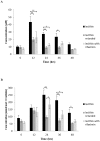Blood Trimethylamine-N-Oxide Originates from Microbiota Mediated Breakdown of Phosphatidylcholine and Absorption from Small Intestine
- PMID: 28129384
- PMCID: PMC5271338
- DOI: 10.1371/journal.pone.0170742
Blood Trimethylamine-N-Oxide Originates from Microbiota Mediated Breakdown of Phosphatidylcholine and Absorption from Small Intestine
Abstract
Elevated serum trimethylamine-N-oxide (TMAO) was previously reported to be associated with an elevated risk for cardiovascular events. TMAO originates from the microbiota-dependent breakdown of food-derived phosphatidylcholine (PC) to trimethylamine (TMA), which is oxidized by hepatic flavin-containing monooxygenases to TMAO. Our aim was to investigate the predominant site of absorption of the bacterial PC-breakdown product TMA. A healthy human proband was exposed to 6.9 g native phosphatidylcholine, either without concomitant treatment or during application with the topical antibiotic rifaximin, or exposed only to 6.9 g of a delayed-release PC formulation. Plasma and urine concentrations of TMA and TMAO were determined by electrospray ionization tandem mass spectrometry (plasma) and gas chromatography-mass spectrometry (urine). Native PC administration without concomitant treatment resulted in peak plasma TMAO levels of 43 ± 8 μM at 12 h post-ingestion, which was reduced by concomitant rifaximin treatment to 22 ± 8 μM (p < 0.05). TMAO levels observed after delayed-release PC administration were 20 ± 3 μM (p < 0.001). Accordingly, the peak urinary concentration at 24 h post-exposure dropped from 252 ± 33 to 185 ± 31 mmol/mmol creatinine after rifaximin treatment. In contrast, delayed-release PC resulted in even more suppressed urinary TMAO levels after the initial 12-h observation period (143 ± 18 mmol/mmol creatinine) and thereafter remained within the control range (24 h: 97 ± 9 mmol/mmol creatinine, p < 0.001 24 h vs. 12 h), indicating a lack of substrate absorption in distal intestine and large bowel. Our results showed that the microbiota in the small intestine generated the PC breakdown product TMA. The resulting TMAO, as a cardiovascular risk factor, was suppressed by topical-acting antibiotics or when PC was presented in an intestinally delayed release preparation.
Conflict of interest statement
Competing Interests: Authors have no competing interests. Kathrin V. Schmidt, Vera Schuhmann, Frank Kratzer, Sven F. Garbade, Claus-Dieter Langhans, Gert Fricker and Jürgen G. Okun declare to have no conflict of interest. The adult children of Wolfgang Stremmel are shareholders of Lipid Therapeutics GmbH.
Figures


References
-
- Cashman JR, Akerman BR, Forrest SM, Treacy EP. Population-specific polymorphisms of the human FMO3 gene: significance for detoxication. Drug Metab Dispos. 2000;28(2):169–73. - PubMed
MeSH terms
Substances
LinkOut - more resources
Full Text Sources
Other Literature Sources

